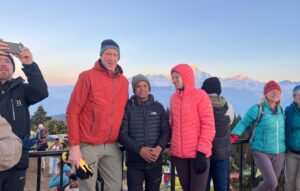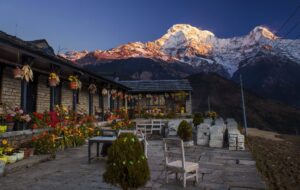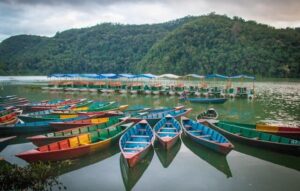Nepal, a land of breathtaking mountains and vibrant cultures, offers some of the most incredible trekking experiences globally. This compact yet diverse country is famed for its towering peaks, including the iconic Mount Everest and its rich blend of traditions and landscapes. Whether you’re a seasoned trekker seeking a challenge or a traveller eager to absorb awe-inspiring views, Nepal Adventure has something special for everyone.
Trekking in Nepal is more than just a physical endeavor; it’s an adventure into one of the world’s most enchanting landscapes. As you explore Nepal’s trekking routes, you’ll traverse varied terrains, from lush forests and tranquil lakes to rugged mountain trails. The beauty of Nepal’s trekking routes and the chance to engage with local cultures make them exceptional.
In this blog post, we’ll explore some of the top trekking routes in Nepal and highlight must-see sightseeing spots. We’ll also explore the Everest, Annapurna, and Langtang regions, providing a comprehensive guide to the best treks and attractions. Whether you’re planning your next adventure or simply dreaming about exploring Nepal, this guide will help you uncover the highlights of this Himalayan gem.
Discover Nepal, where breathtaking mountains meet vibrant cultures and offer some of the world’s most incredible trekking experiences. Nepal has something for everyone, from the iconic Mount Everest to rich traditions and diverse landscapes. Whether you’re a seasoned trekker or a traveller eager to absorb awe-inspiring views, Nepal’s trekking routes promise an unforgettable journey. For more information and planning resources, visit the Nepal Tourism Board.
Adventure in Nepal: The Everest Region
Geographic Overview
Explore Nepal’s Everest region, home to the world’s highest peak, Mount Everest. This northeastern part of Nepal, which is also part of the Khumbu region, features dramatic landscapes and stunning natural beauty. It includes several high-altitude valleys and peaks and is renowned for its rugged terrain, glacial lakes, and expansive Himalayan views.
Cultural Significance
The Everest region is not only known for its towering peaks but also its rich cultural heritage. It is primarily inhabited by the Sherpa people, known for their mountaineering skills and warm hospitality. The Sherpa culture is deeply intertwined with the region’s trekking routes, and you’ll encounter traditional monasteries, chorten (stupas), and prayer flags along your journey.
Accessibility and Travel Tips
Reaching the Everest region typically involves a flight from Kathmandu to Lukla, a small town with an airport that has one of the world’s most dramatic runways. From Lukla, trekkers embark on their journey, with routes leading to Everest Base Camp and other destinations. Due to the high altitude and variable weather, preparing adequately and allowing for acclimatisation is essential.
Best Time to Visit for the Adventure in Nepal
Plan your trek in the Everest region to explore Nepal effectively during the pre-monsoon (spring) or post-monsoon (autumn) seasons. These times feature stable weather and clear skies. Spring (March to May) delivers the most spectacular views of Everest and nearby peaks, while autumn (September to November) presents mild temperatures and less crowded trails.
Adventure in Nepal with Everest Base Camp Trek
Overview of the Trek
Explore Nepal with the Everest Base Camp trek, one of the most renowned treks worldwide. Firstly, this journey leads you through the majestic Everest region, where you’ll be treated to breathtaking views of Everest, Lhotse, and Nuptse. Additionally, you’ll be able to immerse yourself in the distinctive Sherpa culture.
Key Highlights
- Scenic Views: The trek offers breathtaking views of Everest and surrounding peaks.
- Sherpa Villages: Experience the local culture in traditional villages like Namche Bazaar and Tengboche.
- Monasteries: Visit ancient monasteries and stupas, such as the Tengboche Monastery.
Preparation and Gear
Proper preparation is crucial for the Everest Base Camp trek. Key items include:
- Warm Clothing: Temperatures can drop significantly, especially at higher altitudes.
- Good Quality Boots: Ensure your boots are well-fitted and broken in.
- Sleeping Gear: Consider a sleeping bag rated for sub-zero temperatures.
Challenges and Tips
The Everest Base Camp trek involves significant altitude gain, which can lead to altitude sickness. To minimize risks:
- Acclimatize Properly: First, take your time to adjust to the altitude. Additionally, ensure you allow your body to adapt to the changes in elevation gradually.
- Stay Hydrated: Drink plenty of water to avoid dehydration. Staying hydrated is crucial for maintaining your energy levels.
- Trek Slowly: Maintain a steady pace to prevent exhaustion. Avoid pushing yourself too hard and give your body the chance to acclimate.
Gokyo Lakes Trek for Adventure in Nepal
Overview of the Trek
The Gokyo Lakes trek, an alternative to the Everest Base Camp trek, offers stunning views of Everest and provides perspectives of the surrounding peaks from a different vantage point. This trek takes you to the beautiful Gokyo Lakes, a series of high-altitude lakes surrounded by snow-capped peaks. Consequently, you experience both the Everest region’s breathtaking scenery and the Gokyo Lakes’s serene beauty.
Scenic Attractions
- Gokyo Lakes: Five pristine lakes set against a backdrop of towering mountains.
- Gokyo Ri: A peak offering panoramic views of Everest, Lhotse, and Makalu.
- Cho La Pass: A challenging but rewarding pass with stunning vistas.
Itinerary and Duration
The Gokyo Lakes trek usually takes about 12 to 15 days, depending on your pace and acclimatization needs. The trek typically starts in Lukla and passes through several Sherpa villages before reaching the Gokyo Lakes.
Comparison with Everest Base Camp Trek
While both treks offer spectacular views of Everest, the Gokyo Lakes trek is quieter and less crowded than the Everest Base Camp trek. It also includes the challenging crossing of the Cho La Pass, adding a sense of adventure to the journey.
Adventure in Nepal with Three Passes Trek
Overview and Route
The Three Passes trek is a demanding circuit that takes you across three high mountain passes-Kongma La, Cho La, and Renjo La- and offers a unique and immersive experience. Consequently, this trek is ideal for experienced trekkers seeking a comprehensive exploration of the Everest region’s diverse landscapes. In addition, it provides an opportunity to witness the dramatic contrasts in terrain, which makes the adventure even more rewarding.
Key Passes and Their Significance
- Kongma La: As the highest pass, Kongma La offers breathtaking views of Makalu and Lhotse, providing an unmatched perspective.
- Cho La: Conversely, Cho La is challenging but rewards trekkers with stunning Gokyo Lakes and Everest vistas. Thus, the effort is worth the view.
- Renjo La: Meanwhile, Renjo La delivers panoramic views of Everest, Lhotse, and Makalu. Therefore, it rounds out the trio with its expansive scenery.
Difficulty Level
Explore Nepal’s Three Passes trek is renowned for its demanding nature. Its high altitude and rugged terrain present a significant challenge, so trekkers must be prepared for extended hikes and severe weather conditions.
Recommendations for Trekking
- Training: First, engage in physical training to build stamina and strength. This preparation will enhance your overall performance.
- Altitude Acclimatization: Moreover, allow extra days for acclimatization to prevent altitude sickness. By doing so, you will gradually adjust to the higher elevations and reduce the risk of health issues.
- Guides and Porters: Consider hiring local guides and porters for assistance and safety. This will support local communities and ensure you have experienced help throughout your journey.
The Annapurna Region
Geographic Overview
The Annapurna region, located in central Nepal, is home to a diverse range of landscapes, including subtropical forests and arid high-altitude deserts. Additionally, the region is prominently dominated by the Annapurna massif, which includes several of Nepal’s highest peaks.
Cultural Insights
The Annapurna region is culturally rich and features diverse ethnic groups, including Gurungs, Magars, and Thakalis. Furthermore, the region’s trekking routes provide breathtaking views and a fascinating glimpse into their traditional lifestyles and customs.
Travel Logistics
The Annapurna region is accessible from Pokhara, a city known for its stunning natural beauty. Trekkers typically fly into Pokhara from Kathmandu and then start their trek from various points, including Nayapul and Besisahar.
Ideal Trekking Seasons
The best times to trek in the Annapurna region are during the spring (March to May) and autumn (September to November). These seasons offer stable weather and clear views of the mountains.
Annapurna Circuit Trek
Trek Overview
The Annapurna Circuit is not only one of the most popular but also one of the most diverse treks in Nepal. It circumnavigates the Annapurna massif, thereby offering trekkers an array of landscapes. Specifically, you can experience everything from lush valleys to, in contrast, high-altitude deserts.
Major Attractions
- Thorong La Pass: The highest point on the trek, offering spectacular views.
- Manang Village: A high-altitude village with stunning scenery and cultural insights.
- Muktinath Temple: A sacred site for both Hindus and Buddhists.
Preparation and Essentials
- Training: First, prepare with physical training and acclimatization, which will improve your endurance.
- Permits: Next, obtain the Annapurna Conservation Area Permit (ACAP) and the Trekkers’ Information Management System (TIMS) card to ensure compliance and a smooth trek.
- Gear: Pack layers of clothing, a good sleeping bag, and essential trekking gear to stay comfortable in varying conditions.
Trekking Experience
The Annapurna Circuit offers a diverse trekking experience characterized by varying climates and cultures along the route. It is renowned for its stunning scenery, challenging passes, and vibrant local communities. Consequently, trekkers can expect a dynamic adventure that seamlessly combines natural beauty with rich cultural encounters.
Annapurna Base Camp Trek
Trek Overview
Explore Nepal with the Annapurna Base Camp trek, a shorter option than the Annapurna Circuit. This trek leads you to the base camp of Annapurna I and offers breathtaking views of the Annapurna massif and its neighbouring peaks.
Highlights and Scenery
- Annapurna Base Camp: A dramatic setting surrounded by towering peaks.
- Machapuchare: Also known as Fish Tail, this peak offers iconic views.
- Himalayan Sunrise: Experience sunrise views over the Annapurna range.
Best Practices and Tips
- Acclimatization: Therefore, spend extra days at higher altitudes to adjust to the elevation. This gradual acclimatization will help prevent altitude sickness and ensure a safer journey.
- Weather: Consequently, check weather forecasts regularly and prepare for changing conditions. By staying informed, you can adapt your plans and gear accordingly.
- Local Culture: Furthermore, respect local customs and interact with friendly communities along the way. In doing so, you will enrich your experience and foster positive relationships with those you encounter.
Comparison with Annapurna Circuit
Explore Nepal with the Annapurna Base Camp trek, which is considerably less strenuous than the more demanding Annapurna Circuit. Consequently, it emerges as an excellent choice for those with limited time or those who prefer a shorter hike. Moreover, it offers stunning views and an intimate experience of the Annapurna massif.
Poon Hill Trek
Overview of the Trek
The Poon Hill trek is relatively short and easy, offering some of the best sunrise views in Nepal. It’s ideal for those with limited time or those looking for a less strenuous trek.
Scenic Views and Highlights
- Poon Hill: This viewpoint not only offers panoramic views of the Annapurna and Dhaulagiri ranges but also provides a stunning perspective of the surrounding mountains.
- Ghandruk Village: Ghandruk Village is a traditional Gurung settlement where you can gain cultural insights and experience local heritage.
- Rhododendron Forests: As you walk through these lush forests, you’ll encounter vibrant blooming rhododendrons, enhancing the serene environment.
Duration and Difficulty
The Poon Hill trek usually takes about 4 to 5 days. It’s considered moderate in difficulty, with a gradual ascent and well-defined trails.
Best Time to Visit
The best times to undertake the Poon Hill trek are during the spring (March to May) and autumn (September to November). These seasons offer clear skies and pleasant temperatures.
The Langtang Region
Introduction to Langtang Region
The Langtang region, located north of Kathmandu, offers a unique trekking experience with its diverse landscapes and rich cultural heritage. It is known for its beautiful valleys, high peaks, and traditional Tibetan-influenced culture.
Accessibility and Travel Tips
The Langtang region is accessible via a drive from Kathmandu to Syabrubesi, the starting point for most treks. Compared to other trekking areas, it is relatively easy to reach and offers a more remote and tranquil experience.
Optimal Trekking Seasons
The best times to trek in the Langtang region are during the spring (March to May) and autumn (September to November). These seasons provide stable weather and clear views of the mountains.
Langtang Valley Trek
Overview and Highlights
The Langtang Valley trek is renowned for its stunning natural beauty and rich cultural experiences. As you embark on this journey, you will traverse lush forests and pass through traditional villages. Moreover, the trek presents spectacular views of the majestic Langtang range, making it an unforgettable adventure.
Itinerary and Duration
The Langtang Valley trek typically takes 7 to 10 days. It starts from Syabrubesi and follows a route through several picturesque villages before reaching Kyanjin Gompa.
Cultural Experiences
- Local Villages: Interact with the Tamang and Sherpa communities.
- Monasteries: Visit local monasteries, such as Kyanjin Gompa.
- Traditional Customs: Learn about local traditions and practices.
Preparation Tips
- Permits: First, obtain the Langtang National Park permit. Then, make sure you have all the necessary documentation.
- Acclimatization: Next, spend time acclimatizing to avoid altitude sickness. This step is crucial for a safe experience.
- Gear: Finally, pack appropriate clothing for varying weather conditions. Being prepared for different scenarios is essential.
Gosaikunda Lake Trek
Trek Overview
Explore Nepal with the Gosaikunda Lake trek. This journey leads to the sacred Gosaikunda Lake, an esteemed high-altitude site for Hindus and Buddhists. It provides a blend of spiritual and scenic encounters.
Major Attractions
- Gosaikunda Lake: A sacred lake, is not only surrounded by snowy peaks but also offers a serene and picturesque setting.
- Laurebina La Pass offers panoramic views of the surrounding peaks and provides an excellent vantage point for appreciating the majestic landscape.
- Helambu Region: This region allows you to experience its cultural diversity and consequently gain insight into the rich traditions and lifestyles of the local communities.
Challenges and Essentials
- Altitude: Therefore, prepare for high-altitude trekking by acclimatizing properly. This will help you adapt more effectively.
- Weather: Be prepared for cold temperatures and possible snow.
- Permits: Obtain necessary permits for the Langtang and Gosaikunda regions.
Comparison with Langtang Valley Trek
While both treks offer beautiful scenery and cultural experiences, the Gosaikunda Lake trek includes higher altitudes and more challenging terrain than the Langtang Valley trek.
Tamang Heritage Trail
Overview of the Trail
Explore Nepal on the Tamang Heritage Trail, where a cultural journey unfolds that reveals the traditions and lifestyle of the Tamang people. Moreover, this trail guides you through traditional villages and picturesque landscapes.
Cultural and Scenic Highlights
- Tamang Villages: Explore traditional Tamang villages and their customs.
- Rural Landscapes: Enjoy picturesque views of terraced fields and forests.
- Local Festivals: Experience local festivals and celebrations.
Duration and Experience
The Tamang Heritage Trail typically takes about 7 to 10 days. The trek offers a blend of cultural immersion and natural beauty.
Best Trekking Practices
- Respect Traditions: Show respect for local customs and traditions.
- Cultural Engagement: Engage with local communities and learn about their lifestyle.
- Prepare for Terrain: Be prepared for diverse terrain and weather conditions.
Sightseeing Destinations for Adventure in Nepal
Kathmandu Valley
Major Attractions
Kathmandu, the capital city of Nepal, is a vibrant hub of history and culture. Key attractions include:
- Swayambhunath Stupa: Also known as the Monkey Temple, offering panoramic views of the city.
- Patan Durbar Square: A historical square with beautiful temples and palaces.
- Boudhanath Stupa: One of the largest stupas in Nepal, important for Buddhists.
Historical and Cultural Sites
Kathmandu Valley is home to several UNESCO World Heritage Sites, including:
- Pashupatinath Temple: A major Hindu pilgrimage site.
- Bhaktapur Durbar Square: Known for its medieval architecture and vibrant festivals.
Tips for Tourists
- Local Cuisine: Try traditional Nepali dishes such as momos and dal bhat.
- Cultural Etiquette: Dress modestly and be respectful of local customs.
- Transportation: Use local taxis or walk to explore the city.
Recommended Itineraries
- Day 1: Explore Kathmandu Durbar Square and Swayambhunath.
- Day 2: Visit Pashupatinath and Boudhanath.
- Day 3: Take a day trip to Bhaktapur and Patan.
Adventure in Pokhara
Key Attractions
Pokhara, a city known for its stunning natural beauty, offers a range of attractions:
- Phewa Lake: A serene lake with boat rides and views of the Annapurna range.
- Sarangkot: A viewpoint offering spectacular sunrise and sunset views.
- Devis Falls: A popular waterfall with a dramatic drop.
Natural Beauty and Activities
Pokhara is a haven for outdoor activities:
- Paragliding: Experience the thrill of flying over the city and lake.
- Trekking: Access to several trekking routes, including the Annapurna region.
- Cave Exploration: Visit the Gupteshwor Cave and other local caves.
Best Time for the Adventure in Pokhara
Consequently, the ideal periods to explore Pokhara are spring (March to May) and autumn (September to November). These seasons offer not only clear skies but also enjoyable weather. Therefore, it is highly recommended to visit during these times to appreciate the scenic beauty and pleasant conditions fully.
Travel Tips
- Accommodation: Choose from a range of hotels and guesthouses.
- Local Transport: Use taxis or rented bicycles to explore the city.
- Safety: Be cautious around water bodies and follow safety guidelines for adventure activities.
Lumbini
Historical Significance
Lumbini is the birthplace of Siddhartha Gautama, who later became known as Buddha. It is a major pilgrimage site for Buddhists worldwide.
Major Attractions
- Maya Devi Temple: The temple marks the exact spot where Buddha was born.
- Lumbini Garden: A peaceful garden with monasteries and meditation spots.
- Sacred Garden: Includes the sacred pool where Queen Maya Devi is believed to have bathed.
Visiting Tips
- Respectful Attire: Dress modestly when visiting religious sites.
- Local Guides: Consider hiring a guide to gain deeper insights into the historical significance.
- Travel Arrangements: Lumbini is accessible from Butwal or Kathmandu via road.
Cultural Insights
Explore Nepal by visiting Lumbini, a center of Buddhist culture and heritage. To begin with, participate in local ceremonies and, in addition, witness traditional practices to enhance your experience. Furthermore, immerse yourself in the serene environment and, as a result, gain a deeper understanding of the region’s spiritual significance.
Adventure Tour in Chitwan National Park
Wildlife and Nature
Chitwan National Park, located in the southern Terai region, is renowned for its diverse wildlife and rich natural habitat. Key attractions include:
- Rhinos: Spot one-horned rhinos in their natural habitat.
- Bengal Tigers: Although elusive, the park is home to these majestic big cats.
- Bird Watching: The park is a birdwatcher’s paradise with numerous species.
Activities and Experiences
- Jungle Safari: You can explore the park’s wildlife either by jeep or, alternatively, by elephant safari.
- Canoeing: Also, paddle along the Rapti or, if you prefer, the Narayani rivers.
- Cultural Programs: Furthermore, attend traditional Tharu cultural performances.
Visiting Guidelines
- Permits: Obtain a permit to enter the park.
- Guides: Hire experienced guides for safaris and park tours.
- Safety: Follow park regulations and safety guidelines for wildlife encounters.
Travel Recommendations
- Accommodation: You should stay in lodges or resorts near the park. These accommodations provide convenient access to the park’s attractions.
- Best Time to Visit: The dry season spans from October to March and is ideal for wildlife viewing. This period offers clearer skies and less rain, enhancing your experience.
- Packing Tips: To ensure a comfortable trip, bring binoculars, sunscreen, and insect repellent. These items will help you enjoy the park’s wildlife and protect you from the elements.
Practical Tips for Trekking Adventure in Nepal
Health and Safety
Vaccinations and Health Precautions
Before you explore Nepal, make sure you’re current on routine vaccinations. Also, consider getting vaccinated for hepatitis A, hepatitis B, typhoid, and Japanese encephalitis.
Safety Tips and Guidelines
- Altitude Sickness: Acclimatize gradually to avoid altitude sickness.
- Travel Insurance: Obtain comprehensive travel insurance covering trekking and medical emergencies.
- Emergency Contacts: Keep a list of emergency contacts, including local guides and rescue services.
Gear and Packing
Essential Gear List
- Trekking Boots: Invest in high-quality, comfortable boots.
- Clothing: Pack moisture-wicking layers, a down jacket, and waterproof gear.
- Sleeping Bag: Choose a sleeping bag rated for cold temperatures.
Packing Tips and Recommendations
- Lightweight Gear: Opt for lightweight and packable gear to ease your load.
- Hydration: Carry a reusable water bottle and purification tablets.
- First Aid Kit: Include basic medical supplies, such as bandages and pain relievers.
Rental vs. Buying Gear
Consider renting trekking gear if you only plan to trek occasionally. For frequent trekkers, investing in quality gear may be more cost-effective and comfortable.
Cultural Sensitivity
Respecting Local Customs
- Dress Modestly: Wear appropriate clothing when visiting religious and rural areas.
- Greetings: Use traditional greetings such as the ‘Namaste’ with folded hands.
- Behaviour: Avoid loud behaviour and respect local traditions.
Dos and Don’ts
- Do: Follow local customs and be polite.
- Don’t Disrespect religious sites or take photos where prohibited.
Interaction with Local Communities
- Engagement: Engage with locals respectfully and learn about their traditions.
- Support: Buy souvenirs from local artisans to support their livelihoods.
Permits and Regulations for Adventure in Nepal
Required Permits for Nepal Adventure Treks
- Everest Region: TIMS card and Sagarmatha National Park permit.
- Annapurna Region: ACAP and TIMS card.
- Langtang Region: Langtang National Park permit.
Nepal Adventure: Visa and Travel Regulations
- Visa: Obtain a tourist visa for Nepal upon arrival or in advance.
- Entry Regulations: Ensure your passport is valid for at least six months.
Environmental Considerations
- Leave No Trace: Follow environmental guidelines to minimize your impact.
- Waste Management: Dispose of waste properly and carry out all non-biodegradable trash.
Discover Nepal’s unique mix of adventure and cultural depth, from the majestic Everest peaks to the tranquil beauty of Pokhara. Whether you’re searching for thrilling hikes or peaceful sightseeing, this Adventure in Nepal has it all. For a tailored travel experience and expert advice, explore Kalpa Holidays and let us assist in crafting your memorable journey through Nepal.







2 Comments
brechobebe.com.br November 30th, 2025
For newest information you have tto go to seee internet and on world-wide-web I found this web page as a most excellent site for newest updates. https://brechobebe.com.br/index.php/author/luellablain/
Ingeborg November 30th, 2025
Thhat is a very good tip especially to those fresh to the blogosphere. Brief but very precise info… Many thanks for sharing this one. A must read article! https://Www.Waste-Ndc.pro/community/profile/tressa79906983/